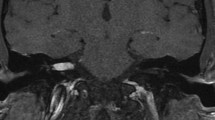Abstract
Management of vestibular schwannomas (VSs) had been the neurosurgeons’ responsibility since Cushing’s time. This practice, however, has been changing during the last 10–15 years. With the blossoming of microsurgery, skull base approaches, radiosurgery, and stereotactic radiotherapy, neurosurgeons, otologists, and radiation oncologists are claiming a role as stakeholders, as individuals or as part of a multidisciplinary team. The good news is that expertise in each of the specialties pushes the standard of care to unprecedented heights with near-zero operative mortality. Facial nerve injury is a rare occurrence, and hearing preservation is a realistic goal. However, such high standards may not be achievable in communities where the case load, surgical expertise, and/or state-of-the-art technology are lacking.
Access provided by Autonomous University of Puebla. Download conference paper PDF
Similar content being viewed by others
Keywords
Management of vestibular schwannomas (VSs) had been the neurosurgeons’ responsibility since Cushing’s time. This practice, however, has been changing during the last 10–15 years. With the blossoming of microsurgery, skull base approaches, radiosurgery, and stereotactic radiotherapy, neurosurgeons, otologists, and radiation oncologists are claiming a role as stakeholders, as individuals or as part of a multidisciplinary team. The good news is that expertise in each of the specialties pushes the standard of care to unprecedented heights with near-zero operative mortality. Facial nerve injury is a rare occurrence, and hearing preservation is a realistic goal. However, such high standards may not be achievable in communities where the case load, surgical expertise, and/or state-of-the-art technology are lacking.
Many treatment algorithms exist, with consensus in some areas but controversy in others. For example, most agree that small intracanalicular VSs in elderly patients can be actively observed. VSs with a diameter of <3 cm can be treated by microsurgery or radiosurgery, depending on the availability of expertise or by patient choice. In this volume of Acta Neurochirurgica Supplement, Hori and Maruyama [2] highlight the excellent microsurgical outcome, and Hayashi et al. [1] illustrate the class leading results of Gamma Knife surgery (GKS). Also, Polovnikov et al. [5], discussing multifraction stereotactic radiotherapy, provide an additional choice for patients who are not suitable candidates for open surgery or radiosurgery.
There is no consensus, however, on the management of large VSs with diameters equal or larger than 3 cm. Treatment options range from gross total resection (GTR), subtotal resection, combined microsurgery and GKS, and stereotactic radiotherapy alone. The proponents of GTR claimed excellent results, but facial nerve damage still occurred in 25 % even in the best hands [9]. To minimize this devastating complication, some authors recommend subtotal debulking and use radiosurgery as salvage. Recently, one center reported planned microsurgery and GKS for large VSs with excellent results: 92 % tumor control rate and only 6 % facial nerve injury [10]. We use a similarly planned microsurgery plus GKS approach for large VSs in a prospective study that has been ongoing since 1998. Additionally, it is the same neurosurgeon who performs the case selection, informed consent, microsurgery, and subsequent radiosurgery. In this era of super subspecialization, this same team approach is rather unique but has obvious advantages. Professor Lars Leksell, inventor of the Gamma Knife, already had this vision in 1983, stating that “the same individual can be a competent microsurgeon and also a stereotactic radiosurgeon” [3]. We presented our preliminary results of 63 cases of large VSs previously, reporting a mean 90 % volume reduction in all cases and zero mortality plus near-zero facial nerve injury [11].
Further controversy exists when radiation is used to treat VSs [4, 7]. We believe in healthy competition rather than monopoly by a single technology, be it GKS, LINAC, proton beam, or stereotactic radiotherapy. Nevertheless, based on having a larger volume of published data, particularly studies with long-term follow-up [6], GKS seems to lead the field.
Vestibular schwannoma is an uncommon disease. Its prevalence is around 1:100,000 per year. The mean number of neurosurgeons in developed countries, such as the European Union, is approximately 1:100,000 population [8]. In a closed community, this equates to one new case per neurosurgeon per year. Inevitably, some patients are managed by otologists or radiation oncologists, further diluting the case load per neurosurgeon. Without concentrated experience, young neurosurgeons may never achieve the level of surgical skills of the giants in the field, such as House, Samii, or Malis.
Vestibular schwannoma used to be a disease managed primarily by neurosurgeons. It remains a fact that no other specialist has the same depth of knowledge in clinical presentation, neuroimaging, neuroanatomy, surgical anatomy, operative approaches, stereotactic techniques, and treatment-related complications and how to deal with them. We propose that neurosurgeons take the leadership by setting up Centers of Excellence with an open and accountable database in their community. All neurosurgeons with interests in VS must have thorough training in the skull base approach, microsurgical technique, and intraoperative neuromonitoring as well as training in stereotactic radiosurgery, such as with the Gamma Knife. For complex cases such as large VSs in patients with serious co-morbid diseases, VS affecting the only hearing ear, and VS in patients with neurofibromatosis type 2, among others, engaging in dialogue with otologists, radiation oncologists, and patients themselves is crucial for selecting the best treatment options. With the team approach led by neurosurgeons, the 21st century can witness near-zero mortality and morbidity when managing VS of whatever size and medical complexity.
References
Hayashi M, Chernov MF, Lipski SM, Tamura N, Yomo S, Horiba A, Tsuzuki S, Izawa M, Okada Y, Muragaki Y, Iseki H, Ivanov P, Regis J, Takakura K (2013) Do we really still need an open surgery for treatment of patients with vestibular schwannomas? Acta Neurochir Suppl 116:25–36 (present volume)
Hori T, Maruyama T (2013) Whether gamma knife radiosurgery is really necessary for treatment of patients with vestibular schwannomas. Acta Neurochir Suppl 116:19–23 (present volume)
Leksell L (1983) Stereotactic radiosurgery. J Neurol Neurosurg Psychiatry 46:797–803
Murphy ES, Suh JH (2011) Radiotherapy for vestibular schwannomas: a critical review. Int J Radiat Oncol Biol Phys 79:985–997
Polovnikov ES, Anikeeva OY, Filatov PV, Krivoshapkin AL, Melidi EG, Gavronina OA, Gaitan AS, Bedny IV (2013) Stereotactic radiosurgery and hypofractionated stereotactic radiotherapy for management of vestibular schwannomas: initial experience with 17 cases. Acta Neurochir Suppl 116:37–44 (present volume)
Prasad D, Steiner M, Steiner L (2000) Gamma surgery for vestibular schwannoma. J Neurosurg 92:745–759
Radiosurgery Practice Guideline Initiative (2006) Stereotactic radiosurgery for patients with vestibular schwannomas: radiosurgery practice guideline report #4-06. http://www.irsa.org/AN%20Guideline.pdf. Accessed 30 Dec 2011
Reulen HJ, Hide RA, Bettag M, Bodosi M, Cunha E, Sa M (2009) A report on neurosurgical workforce in the countries of the EU and associated states. Task Force “Workforce Planning”, UEMS Section of Neurosurgery. Acta Neurochir (Wien) 151:715–721
Samii M, Gerganov VM, Samii A (2010) Functional outcome after complete surgical removal of giant vestibular schwannomas. J Neurosurg 112:860–867
van de Langenberg R, Hanssens PE, van Overbeeke JJ, Verheul JB, Nelemans PJ, de Bondt BJ, Stokroos RJ (2011) Management of large vestibular schwannoma. Part I. Planned subtotal resection followed by Gamma Knife surgery: radiological and clinical aspects. J Neurosurg 115:875–884
Yu CP, Leung S, Poon C, Fan YW, Ng B, Chan J, Ho R (2010) Combined microsurgery plus Gamma Knife by the same team for large skull base tumors: towards zero mortality and near zero morbidity in 381 cases. In: Scientific program and schedule of events of the 15th international meeting of the Leksell Gamma Knife® Society, Athens, 16–20 May 2010, p 99
Conflict of Interest
The author declares that he has no conflict of interest.
Author information
Authors and Affiliations
Corresponding author
Editor information
Editors and Affiliations
Rights and permissions
Copyright information
© 2013 Springer-Verlag Wien
About this paper
Cite this paper
Yu, C.P. (2013). Contemporary Role of Microsurgery, Radiosurgery, and Stereotactic Radiotherapy in the Management of Vestibular Schwannomas. In: Chernov, M., Hayashi, M., Ganz, J., Takakura, K. (eds) Gamma Knife Neurosurgery in the Management of Intracranial Disorders. Acta Neurochirurgica Supplement, vol 116. Springer, Vienna. https://doi.org/10.1007/978-3-7091-1376-9_3
Download citation
DOI: https://doi.org/10.1007/978-3-7091-1376-9_3
Published:
Publisher Name: Springer, Vienna
Print ISBN: 978-3-7091-1375-2
Online ISBN: 978-3-7091-1376-9
eBook Packages: MedicineMedicine (R0)




